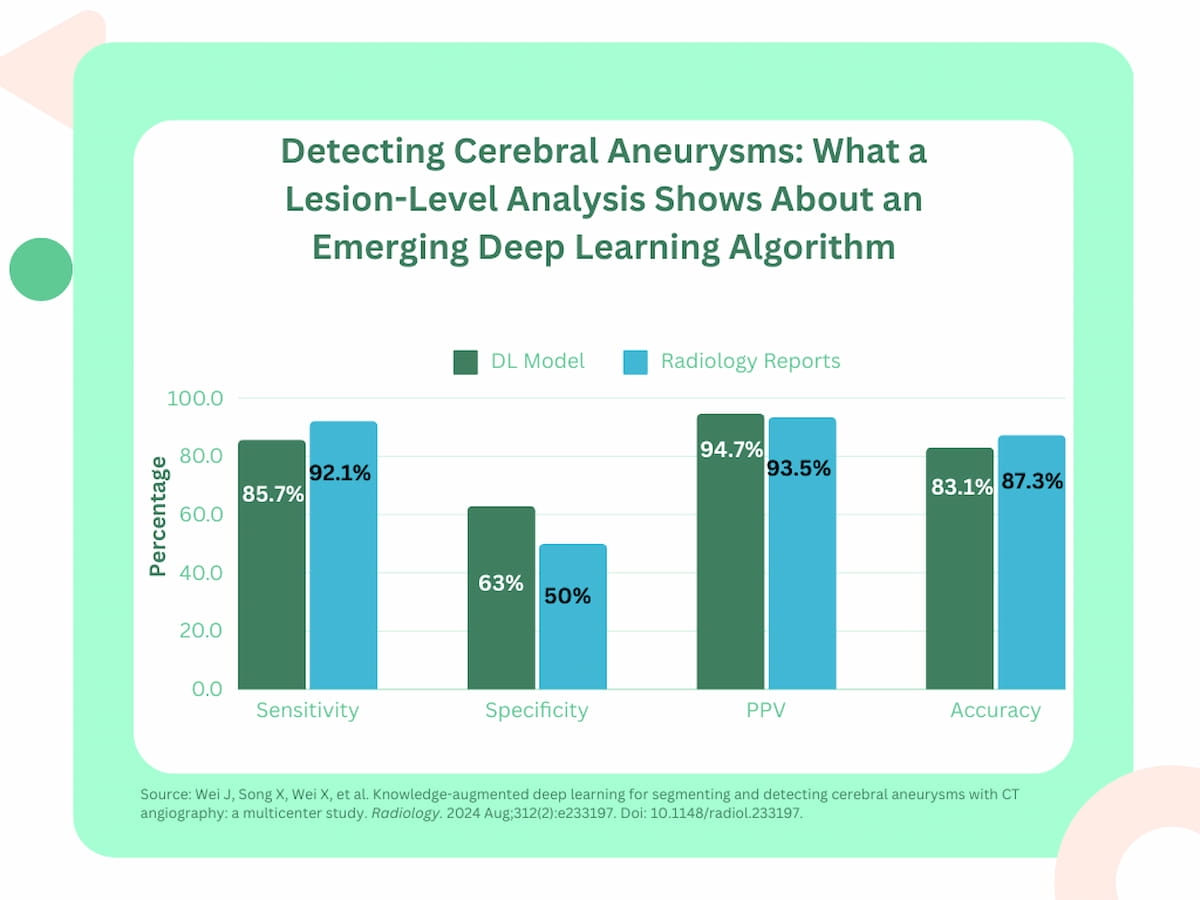An emerging deep learning algorithm may provide a viable alternative for efficient segmentation and detection of cerebral aneurysm on computed tomography angiography (CTA), according to the results of a new multicenter study.
For the research, recently published in Radiology, researchers developed and examined the use of a convolutional neural network-based deep learning model in a total cohort of 6,060 patients (mean age of 56) who had head and neck CTA for suspected unruptured cerebral aneurysms. External validation testing of the model was performed in 118 patients (mean age of 59), according to the study.
In internal testing involving 632 patients, the study authors found the deep learning model demonstrated a 96 percent DSC for vessel lumen segmentation and an 87 percent DSC for cerebral aneurysm segmentation. From image reconstruction to detection, the researchers pointed out a processing time of 1.76 minutes per CTA scan.
“We developed a prior knowledge–augmented convolutional neural network–based model for accurate cerebral aneurysm segmentation and detection on CT angiography images based on, to our knowledge, the largest currently available sample size from a multicenter data set that includes different CT scanners. … The trained model showed notable performance with state-of-the-art segmentation,” wrote lead study author Jianyong Wei, M.D., who is affiliated with the Clinical Research Center at the Shanghai Sixth People’s Hospital and the Shanghai Jiao Tong University School of Medicine in Shanghai, China, and colleagues.
In external validation testing, the study authors found that the deep learning model had an 85.7 percent sensitivity rate for diagnosing cerebral aneurysms in comparison to 92.1 percent in radiology reports emphasizing digital subtraction angiography (DSA) results. The researchers noted there was no statistically significant difference.
Similarly, the study authors showed the deep learning model had comparable findings to radiology reports in a lesion-level analysis with respect to accuracy (83.1 percent vs. 87.3 percent) and positive predictive value (PPV) (94.7 percent vs. 93.5 percent).
Three Key Takeaways
1. High accuracy in segmentation. The deep learning model demonstrated a high level of accuracy, achieving a Dice similarity coefficient (DSC) of 96 percent for vessel lumen segmentation and 87 percent for cerebral aneurysm segmentation in internal testing involving 632 patients.
2. Efficiency in detection. The algorithm is efficient, with a total processing time of approximately 1.76 minutes per CTA scan, making it a viable alternative for rapid detection and segmentation in clinical settings.
3. Comparable sensitivity and accuracy. In external validation, the model showed comparable sensitivity and accuracy to traditional radiology reports, with a sensitivity rate of 85.7 percent and lesion-level accuracy of 83.1 percent, though it had slightly lower sensitivity for detecting smaller lesions (3-5 mm) compared to digital subtraction angiography (DSA).
The deep learning model had lower sensitivity than DSA for 3 to 5 mm lesions (79 percent vs. 92 percent) but offered equivalent sensitivity to DSA (80 percent) for lesions < 3 mm, according to the researchers. The study authors also suggested the deep learning model may be device-agnostic with similar results across CT scanner models from different manufacturers.
“The (deep learning) model exhibited stable performance across these CT scanner manufacturers, achieving AUCs ranging from 0.92 to 0.99,” pointed out Wei and colleagues.
(Editor’s note: For related content, see “Image IQ Quiz: When There is a Calcified Mass Within the Sella Turcica,” “CTA AI Tool for Cerebral Aneurysm Detection ‘Advances the Field,’” and “FDA Clears AI-Powered Qualitative Perfusion Mapping for Cone-Beam CT.”)
In regard to study limitations, the authors acknowledged the exclusion of CTA findings with arteriovenous malformations. They also suggested the inclusion of suspected cases of unruptured aneurysms in the training and testing of the deep learning model may indicate a higher detection rate of aneurysms that one may see in daily practice. The researchers conceded the use of data from a single tertiary facility for external validation testing of the deep learning model.
